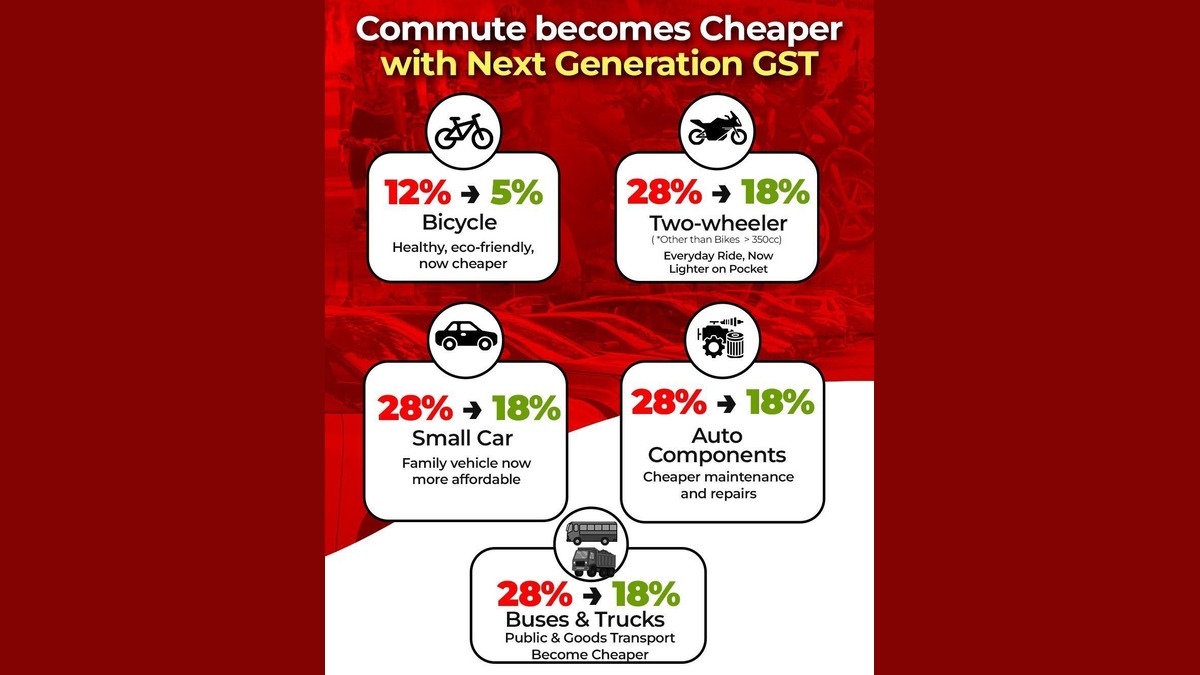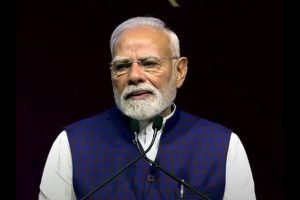The new GST rates and slabs will have a wide-scale positive impact on the many items related to heavy industries, be it auto, transport, or auto ancillaries.
For instance, the rate cuts for the automobile sector are across different categories. It includes bikes (up to 350cc, which also accommodates bikes of 350cc), Buses, Small cars, Medium and luxury cars, Tractors (<1800cc), among others.
The rates are also being reduced on auto parts.
“Lower GST will push demand, helping automobile manufacturers and the large ancillary industry (tyres, batteries, components, glass, steel, plastics, electronics, etc),” the Ministry of Heavy Industries said in a note on Monday.
Rising sales of vehicles will increase orders for these components, creating a multiplier effect on MSMEs, which form a large part of this supply chain, the Ministry said.
As per estimates, the entire auto industry directly and indirectly supports over 3.5 crore jobs in manufacturing, sales, financing, and maintenance.
“A demand boost will lead to new hiring in dealerships, transport services, logistics, and component MSMEs,” the Ministry said. “Informal sector jobs (drivers, mechanics, small service garages) will also benefit.”
Vehicle purchases are also credit-driven (NBFCs, banks, fintech lenders).
“A revival in auto sales will support retail loan growth, improve asset quality, and expand financial inclusion in semi-urban India,” said the ministry. “Policy certainty through rational GST rates encourages fresh investments in the automobile sector. It will also promote Make In India and the manufacturing sector.”
The Ministry believes that the GST rate cuts will also encourage the replacement of old vehicles with new, fuel-efficient models, thereby supporting cleaner mobility.
For two-wheelers, including bikes up to 350cc, the GST rate has been reduced from 28% to 18%.
“Lower GST will reduce prices of bikes, making them more accessible to youth, professionals, and lower-middle-class households. Bikes are the primary mode of transport in rural and semi-urban India; cheaper bikes will directly benefit farmers, small traders, and daily wage earners. It is expected to help gig workers and boost the savings of the gig workers, through reduced costs and EMI for 2-wheeler loans,” the ministry said.
For small cars, the GST rate has been reduced to 18% from 28%.
The small car encompasses petrol engine cars of <1200 cc and not exceeding 4 metres in length, and diesel cars of <1500 cc and not exceeding 4 metres in length.
“Cars in the affordable segment will become cheaper, encouraging first-time buyers and expanding household mobility. Reduced GST will stimulate sales in smaller cities and towns where small cars dominate. Higher sales will benefit car dealerships, service networks, drivers, and auto-finance companies,” the Ministry said.
For large cars, however, GST is tagged at a flat 40% with no cess.
“Removal of the additional cess has not only reduced the rates but also makes taxation simple and predictable,” the Ministry said. “Even at 40%, the absence of cess will lower the effective tax on larger cars, making them relatively more affordable for aspirational buyers.”
For the agricultural sector, tractors, which were previously taxed at 12 per cent GST, will now be taxed at 5 per cent. Tractor tyres and parts, which were in the 18 per cent slab, have also been brought down to 5 per cent.
“India is one of the world’s largest tractor markets; GST cut will push demand in both domestic and export segments. The components for tractor manufacturing like tyres, gears etc will also be taxed at 5% only. Ancillary MSMEs making engines, tyres, hydraulic pumps, and spare parts will benefit from higher production. The GST Cut will also strengthen India’s positioning as a global tractor manufacturing hub,” the Ministry said.
For buses with a seating capacity of 10+ persons, GST has been reduced from 28% to 18%.
“This will spur demand from fleet operators, corporates, schools, tour operators, and state transport undertakings,” the Ministry said.
The majority of the components used for the manufacture of motorcars and motorbikes have also been reduced by 18%.
In a historic move to simplify the Goods and Services Tax(GST), GST Council in its 56th meeting has reduced the GST structure from four slabs (5%, 12%, 18%, 28%) to two main rates–5% (merit rate) and 18% (standard rate) along with a 40% special rate for sin/luxury goods. These changes come into effect from September 22, 2025.
Sweeping changes have been made to what the government termed the next-generation GST (Goods and Services Tax) rationalisation.
It came on September 3, just days after Prime Minister Narendra Modi announced it from the ramparts of the Red Fort on Independence Day. This is aimed at reducing the tax burden on citizens while stimulating economic growth.





